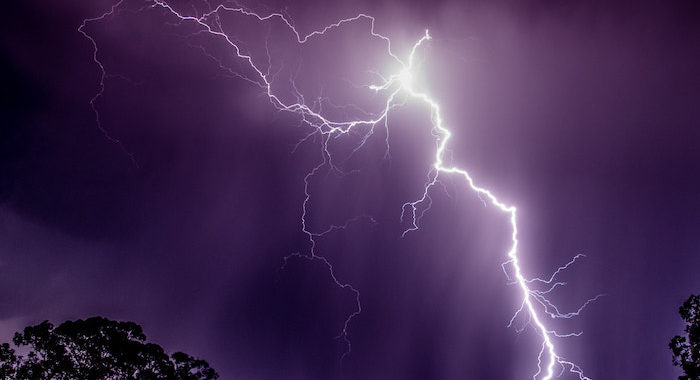Lightning Most lightning strikes average 2 to 3 miles in length, but can strike up to 10 miles laterally Lightning carries a current of 10,000 Amps at 100 million Volts (hotter than the surface of the sun). Lightning Distance Quick Facts Florida is the lightning capital of the world. Lightning is about the size of a Quarter to Half-Dollar. It looks so much wider because it is so bright. How Far is the Lightning? Count the seconds between the lightning strike and when thunder is heard, and then divide that number by 5 (sound travels at a speed of 761 mph or 1100 fps or about one mile in approximately 5 seconds). Example: If 20 seconds, the lightning is about 4 miles away Lightning Meters Lightning Meters can also be used to detect the presence of lightning in the vicinity. These meters indicate the distance to the lightning. Some firms reduce outdoor activities as soon as lightning is detected within 20 miles. Most lightning strikes that involve people occur in elevated locations. The highest point is subject to being struck by lightning. June, 1997, two workers were installing plumbing on the third floor of a three-story apartment building under construction. Both employees were struck by lightning. One was hospitalized and died a few days later. The other worker was hospitalized and released. July 1997, 2:30 PM, 4 employees who were working on a roof parapet were beginning to get their tools together and descend from the roof because of an approaching thunderstorm. While getting their tools, one worker was struck by lightning. He died a few days later Lightning Studies In 2006: Lightning killed at least 43 people in the U.S. (Annual average is 61 fatalities) Hundreds of people are injured by lightning, often with debilitating health effects, such as permanent nerve damage or brain injury. Source: Dr. Mary Ann Cooper of the University of Illinois’s dept. of emergency medicine. Lightning Statistics In continental 48 states, an average of 25,000,000 cloud-to-ground flashes occur every year since the lightning detection network covered all of the continental US in 1989. Half of all flashes have more than one ground strike point or two or more ground hits per flash. The highest frequency of cloud-to-ground lightning is in Florida between Tampa and Orlando. Weather Fatalities Lightning Precautions Stay inside buildings or inside vehicles during a lightning storm Stay away from fences, antennas and metal pipelines that are not grounded Stay away from trees or high structures and seek low ground if shelter is not available Lightning Deaths in US (1990-2003 ) Global Distribution of Lightning 30/30 Rule If thunder is heard within 30 seconds of a lightning strike, suspend all outdoors work-related activities for 30 minutes. Do not resume work until 30 minutes after thunder is last heard. Safety Plan The 30/30 rule: Make sure all workers take shelter, preferably inside a permanent structure. Once inside the structure, stay clear of windows and openings in the structure. If caught outside in a lightning storm do not seek shelter under tall objects such as trees. Lightning Safety Position Drop to a crouched position (The process of getting low increases your safety) Bend forward keeping your head very low (You want to discourage a strike to the head) Place your hands over your ears & close your eyes. Tuck the elbows close to the body. (Minimizes blindness and deafness from a near-by strike) Keep as little contact (small area) as possible with the ground Lightning Safety Position Touch your feet together. (Minimizes the effects of step voltage from a near by strike to the ground) Do not allow any other body parts to touch the ground Never lie flat on the ground If someone is Hit!! Call Emergency Services A victim does not stay electrified and can be touched right away. If the victim has no pulse, try CPR (cardio-pulmonary resuscitation). If there is a portable defibrillator, follow the instructions. But be careful about staying in the open in a storm to take care of a victim- or you can get hit too. If possible, move the victim to a shelter. For More Information, See: www.lightningsafety.noaa.gov Think Safety Work Safely
